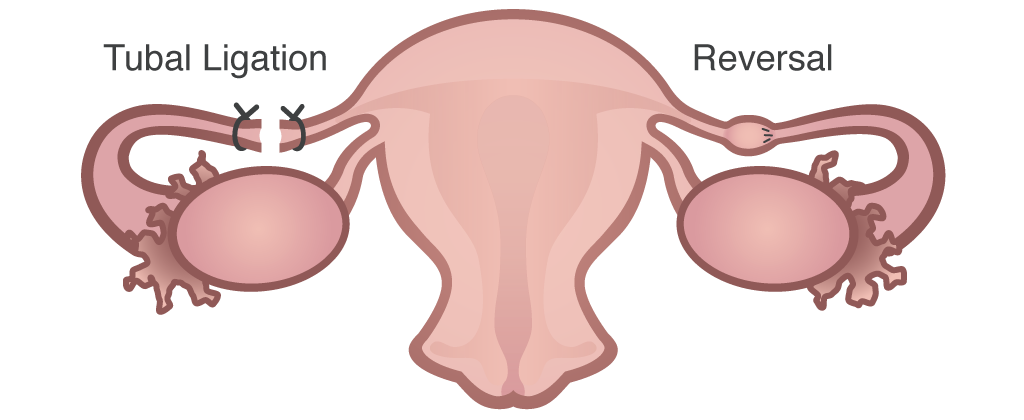Vasectomies do not affect testosterone levels, erections, climaxes, or sex drive.
⚠️ Use Discretion: Graphic human anatomy.
Your Undoing
A vasectomy is a surgical birth control procedure that prevents a man from impregnating a woman. Since this male sterilization does not inhibit the spread of sexually transmitted infections, a prophylactic covering may still be necessary. Though surgical reconnections are possible, it is best to view vasectomies as irreversible.
Get Her To Do It
Comparable female sterilization is called tubal ligation. Instead of severing spermatic chords, a woman’s fallopian tubes are blocked or removed. Mothers sometimes contemplate this after giving birth to several children or if doctors warn that a pregnancy can be life-threatening. Currently, laparoscopic tubal ligation is the most popular method of female sterilization in non-pregnant women.
When people say they are having their tubes tied, we envision a neat bow on shoe laces that can easily be undone. Fallopian tubes may be banded, cauterized, or cut and tied. Keloid scar tissue can later fuse crimped passageways, making reversal problematic.

Upon request by the patient, tubal ligation is sometimes performed following the delivery of a child. It may also be done with laparoscopy at other appropriate times.
Though tube tying is quite effective, it is not a foolproof method of contraception. Less than 1 woman out of 200 will conceive, typically resulting from improperly performed procedures or a spontaneous regeneration of the fallopian tubes over time.
Get Him To Do It
Unlike a castration—where testicles are removed—men with a vasectomy can have an erection and ejaculation. The ejaculate is void of spermatozoa. Vasectomies do not affect testosterone levels, erections, climaxes, sex drive, or any other part of sex life.

During a vasectomy, spermatic cords (vas defrens) are cut and tied off. This eliminates the supply of sperm from the testes within ejaculate.
The traditional method for this outpatient procedure is with a scalpel. Through a small slit in the upper part of the scrotum, two tubes called vas defrens are cut and tied off. The site is closed up with a few stitches.
A newer “knife-less surgery” or “no-scalpel” method uses needles, without requiring stitches. Within a few days of either method, pain and swelling are gone. You can have a vasectomy on Friday and return to work on Monday.
After 10–20 ejaculations following the vasectomy, your semen is tested to see if it is free of sperm. Until confirmation is received, you should continue using other birth control methods.
Don’t Count on Reversal
For optimum effectiveness, male or female tubes are preferably severed. Though it is possible to suture detached ends back together, the ability of a man’s sperm to fertilize eggs diminishes over time.
Vasectomy reversal within the first three years has about a 70 percent chance of successful pregnancy. By ten years, this drops to 30 percent. The best insurance against future regret is cryopreservation of semen.
There is a 33 percent risk of an ectopic pregnancy if conception occurs after tubal ligation reversal. This means that the egg is implanted in the fallopian tubes and cannot progress into a healthy pregnancy.
FDA Prophylactic Birth Control Guide
| FDA-Approved Method | Pregnancies Per 100 Women | Frequency of Use | Side Effects |
|---|---|---|---|
| Sterilization Surgery for Women | < 1 | One-time Permanent | Pain; bleeding; post-surgery infections or complications |
| Sterilization Implant for Women | < 1 | One-time Permanent | Pain or cramping; pelvic or back discomfort; vaginal bleeding |
| Sterilization Surgery for Men | < 1 | One-time Permanent | Pain; bleeding; infection |
| IUD Copper | < 1 | Insert by health care provider <10 years | Cramps; heavier, longer periods; spotting between periods |
| IUD with Progestin | < 1 | Insert by health care provider 3–5 years | Irregular bleeding; no periods (amenorrhea); abdominal or pelvic pain |
| Rod Implant | < 1 | Insert by health care provider <3 years | Menstrual changes; weight gain; acne; mood swings; depression; headache |
| Injection | 6 | Every 3 months | Loss of bone density; irregular bleeding; bleeding between periods; weight gain; headaches; nervousness; dizziness; abdominal discomfort |
| Oral Contraceptives (Combined Pill) | 9 | Daily | Bleeding or spotting between periods; nausea; breast tenderness; headache |
| Oral Contraceptives (Extended-Use Combined Pill) | 9 | Daily | Bleeding or spotting between periods; nausea; breast tenderness; headache |
| Oral Contraceptives (Extended-Use Combined Mini Pill) | 9 | Daily | Bleeding or spotting between periods; nausea; breast tenderness; headache |
| Patch | 9 | Change weekly for 3 weeks (max 21 days). | Bleeding or spotting between periods; nausea; breast tenderness; skin irritation; abdominal pain; headache |
| Vaginal Contraceptive Ring | 9 | Personal intravaginal insertion for 3 weeks. Remove 1 week. | Vaginal discharge, discomfort, mild irritation; headache; nausea; mood changes; breast tenderness |
| Diaphragm with Spermicide | 12 | During each copulation | Irritation; allergic reactions; urinary tract infection |
| Sponge with Spermicide | 12–24 | During each copulation | |
| Cervical Cap with Spermicide | 17–23 | During each copulation | Irritation; allergic reaction; abnormal Pap test |
| Male Condom | 18 | During each copulation; Protects against some STIs | Irritation; allergic reaction |
| Female Condom | 21 | During each copulation; Protects against some STIs | Discomfort or pain during insertion or sex; burning sensation; rash; itching |
| Spermicide Alone | 28 | During each copulation | Irritation; allergic reaction; urinary tract infection |
For more information on the chance of getting pregnant while using a method or on the risks of a specific product, please check the product label or “Contraceptive failure in the United States,” Trussell, J. (2011), Contraception 83(5):397-404.
As you can see, when using a condom alone, a sexually active person could potentially conceive 18 times with 100 encounters, or >4 times with 25 encounters. In reality, concurrent pregnancy is not possible and conception will likely slow activity.
A male contraceptive transdermal “gel [that began October 2018 Phase 2b trial] reduces sperm count to a contraceptive level,” says Clint Dart, the Vice President, Biostatistics and Programming at Health Decisions (the CRO running the study). “Once a man’s sperm concentration is low enough (less than 1 million/mL), there is a 97 percent chance that their partner will not get pregnant.”
Religious Considerations
Some religions—notably Catholicism since the second century—forbid all methods of birth control except the rhythm method. “The Church has always taught the intrinsic evil of contraception, that is, of every marital act intentionally rendered unfruitful. This teaching is to be held as definitive and irreformable. Contraception is gravely opposed to marital chastity.” (1997, the Vatican’s Pontifical Council for the Family)
The 2008 Congregation for the Doctrine of the Faith’s instruction Dignitas Personae reiterates church opposition to contraception, mentioning new methods, notably female condoms and morning-after pills, which also “fall within the sin of abortion and are gravely immoral.”
The scriptural basis provided is Psalm 127:3–5, which extols that children are a blessing from God. The command given to Adam in the Garden of Eden and later to Noah’s family was to populate the earth. (Genesis 1:28; 9:1) Throughout the Hebrew Scriptures, childbirth was encouraged with the prospect of being within the lineage of the Messiah. —Genesis 16:9–10; Ruth 4:13.
Barren women were ridiculed. (1 Samuel 1:4–6) Though children are praised within the Christian Greek Scriptures after the arrival of the Messiah, the focus shifted to making disciples from people of the nations. (Colossians 3:11–25; Matthew 24:14; Acts 1:8) Both Hebrew and Greek Scriptures prohibit adultery and premarital sex. —Proverbs 5;16; Hebrews 13:4.
Whether or not religious views are a factor, family planning, including the decision to have a vasectomy or tubal ligation is a serious step for couples to personally decide.
To support the writing of scholarly articles about individual, ClinicalPosters sells human anatomy charts, scientific posters, and other products online. You may sponsor specific articles or remit a small donation.
ClinicalPosters sells human anatomy charts, scientific posters, and other products online to offset expense of the writing useful articles about individual. Slide extra posters into DeuPair Frames without removing from the wall.
Show your support by donating, shopping for ClinicalPins, or leaving an encouraging comment to keep the research going.
To support the writing of useful articles about individual, ClinicalPosters sells human anatomy charts, scientific posters, and other products online. You may sponsor specific articles or remit a small donation.
ClinicalPosters sells human anatomy charts, scientific posters, and other products online to offset expense of the writing useful articles about individual. Slide extra posters into DeuPair Frames without removing from the wall.
ClinicalPosters sells human anatomy charts, scientific posters, and other products online. You may remit a small donation.
You can support the writing of useful articles about individual by sponsoring specific articles or remitting a small donation. Visible content is optimized for device size.







 Romance & Health Intertwine. Fall in love with a captivating romance miniseries that explores the essence of well-being. Become a ClinicalNovellas library member for heartwarming tales.
Romance & Health Intertwine. Fall in love with a captivating romance miniseries that explores the essence of well-being. Become a ClinicalNovellas library member for heartwarming tales.




